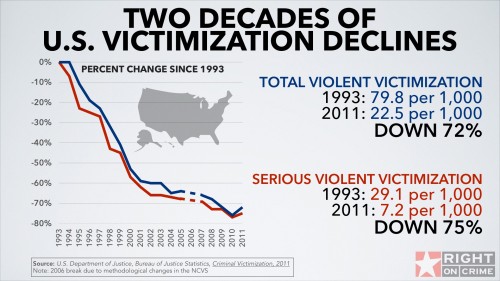
Source: US Department of Justice, Bureau of Justice Statistics
Washington Post– Back in the crack-infused 1980s, young men with guns and drugs ruled the single block of Hanover Place NW. People who lived in the two-story rowhouses one mile north of the Capitol fell asleep year round to the sounds of the Fourth of July, a pop-pop-pop that they hoped was firecrackers. It rarely was.
But after two decades of consistent and dramatic declines in homicides and gun violence in Washington and many other major cities, Hanover Place is mostly quiet these days. Complaints to the police tend to be more about kids shooting craps on the sidewalk than about drug dealers shooting at rival street crews. On a block where houses were unloaded for as little as $30,000 in the 1990s, the most recent sales have ranged from $278,000 to $425,000.
As welcome as such changes have been, explanations for the nation’s plummeting homicide rate remain elusive, stymieing economists, criminologists, police, politicians and demographers. Have new police strategies made a difference, or have demographic shifts and population migrations steered the change? Could the reasons be as simple as putting more bad guys behind bars, or does credit go to changes made a generation ago, such as taking the lead out of gasoline or legalizing abortion?
Read More
Mass shootings such as last year’s searing incidents in Newtown, Conn., and Aurora, Colo., have put gun and mental-health policies back atop the nation’s agenda. But the narrative of crime over the past two decades runs in a different direction. Law and order has largely vanished as a political issue — in 1994, more than half of Americans called crime the nation’s most important problem; by 2012, only 2 percent of those surveyed by Gallup said so. The drop in deaths from firearms and in slayings overall — over the past two decades, homicide declined by 80 percent in the District and overall crime fell by 75 percent in New York City — has come even as the economy has tanked, the number of guns owned by Americans has soared and the number of young people in the prime crime demographic has peaked.
“There has been a real drop in crime, and anyone living in New York or Washington sees it,” said David Greenberg, a New York University sociologist who has tested theories for the decline. “In principle, we should be able to explain it, but it’s easier to determine what factors don’t contribute than it is to say what does.”
I have to admit, even I was surprised by the information in this article. It seems it’s always good to get a different perspective other than what is produced by the hyperventilating left.















I have to admit – I wasn’t surprised. I’ve been saying this all along, but the whiney anti-gun nutjobs just don’t care.
Thomas Midgley Jr
Probably killed more people than anyone else in history.
High atmospheric lead levels have been associated with serious health problems.[12][13][14] J. R. McNeill, an environmental historian, has remarked that Midgley “had more impact on the atmosphere than any other single organism in Earth’s history.”[15]
The decline in the 1990s was due to an improving economy, the aging of the baby boomers beyond the primary violent crime – producing years, & the smaller number of Americans entering those years.
As far as the 2000s go, the children of the baby boomers are different. Teenage pregnancy being a post-World War II low is one example.
I think.